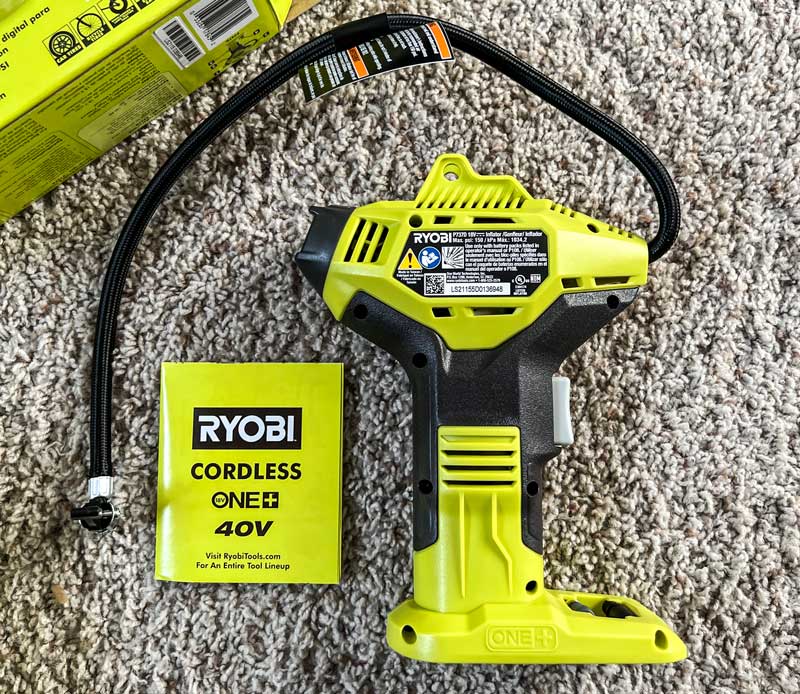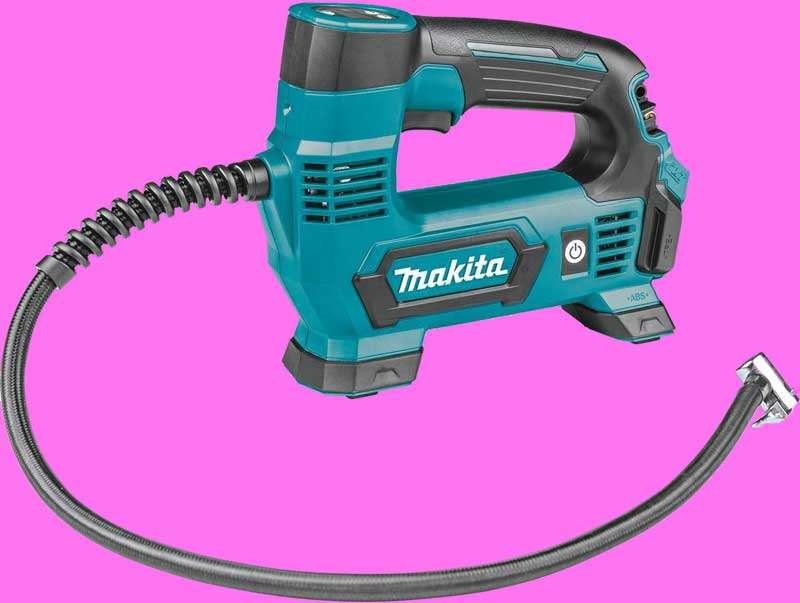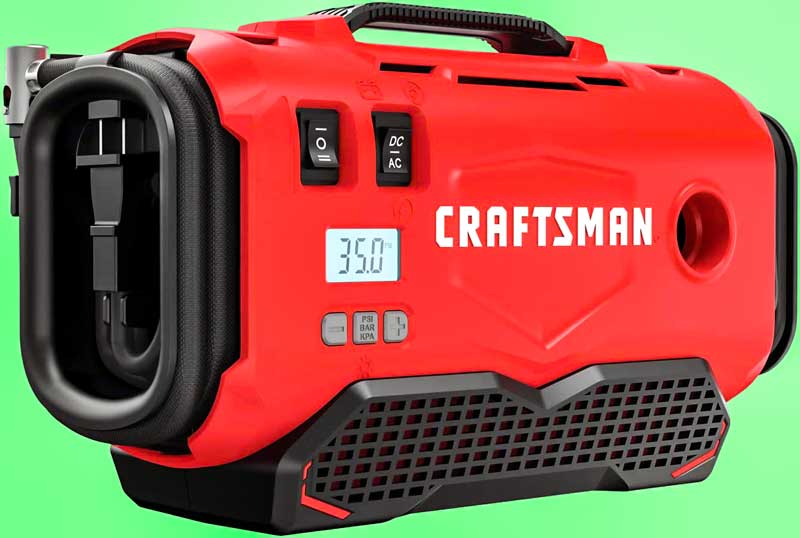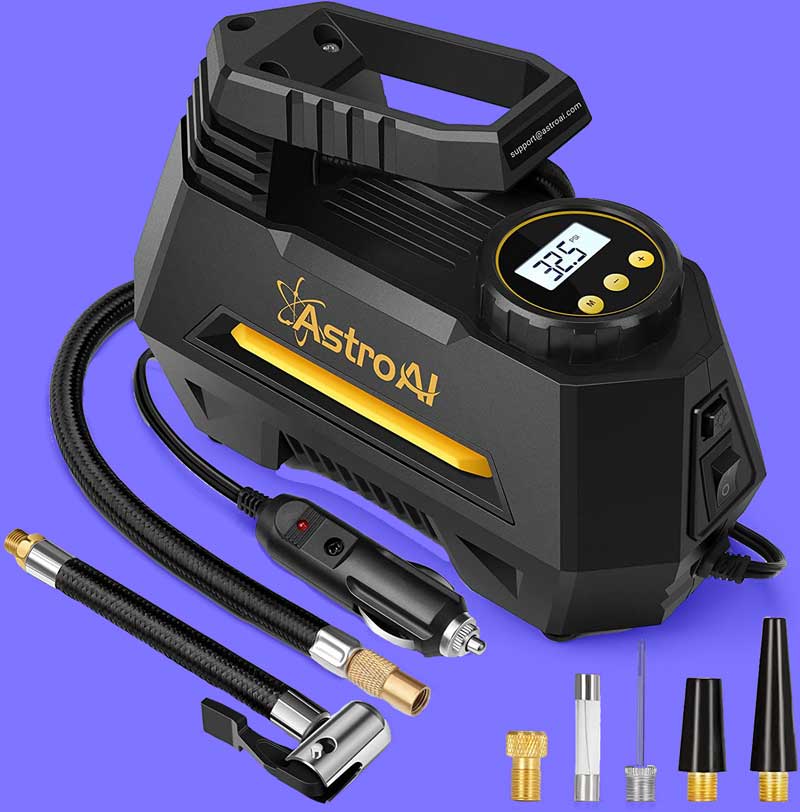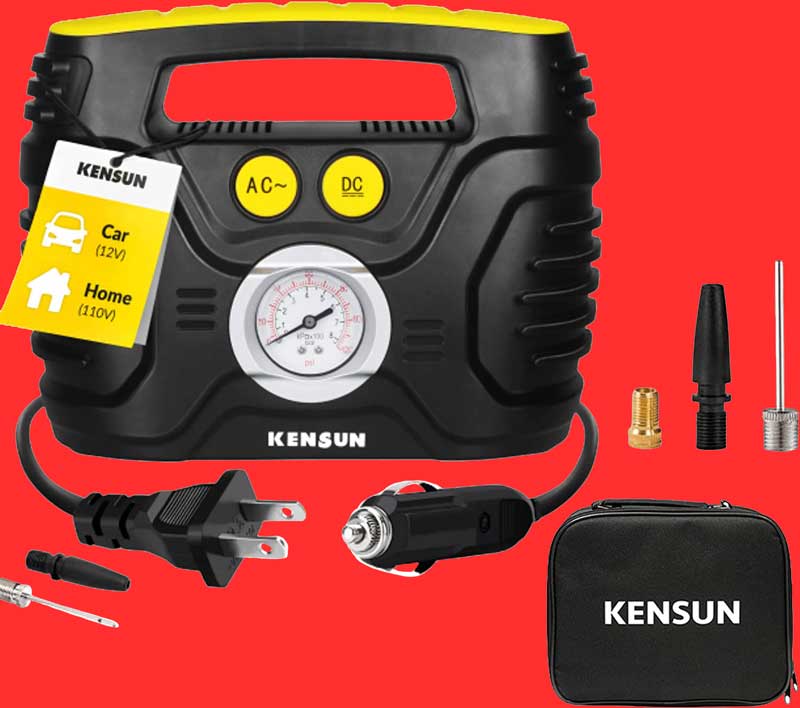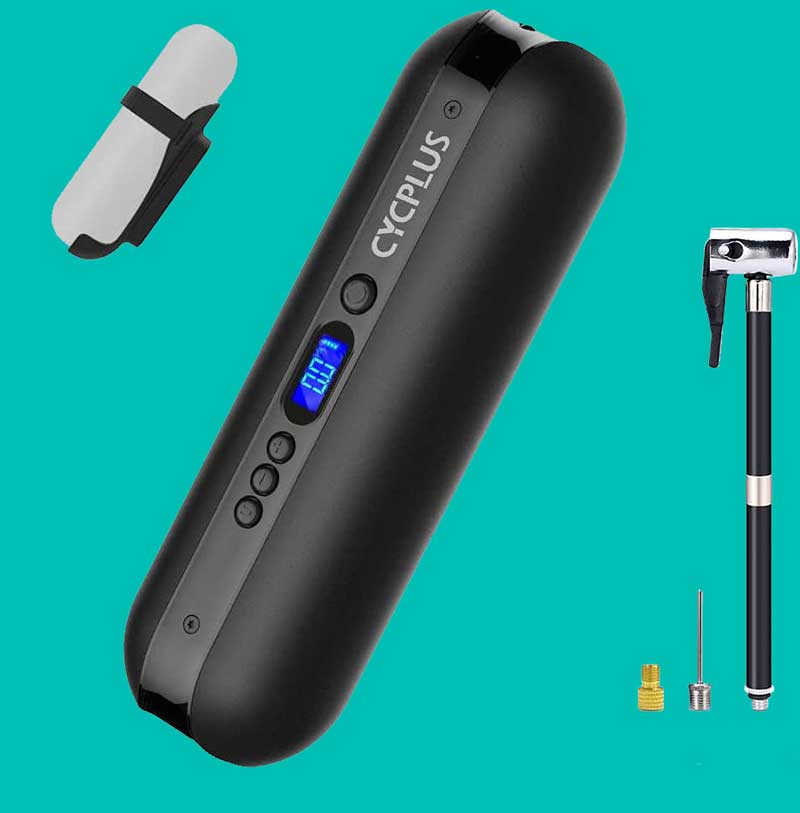Best Tire Inflators for 2024
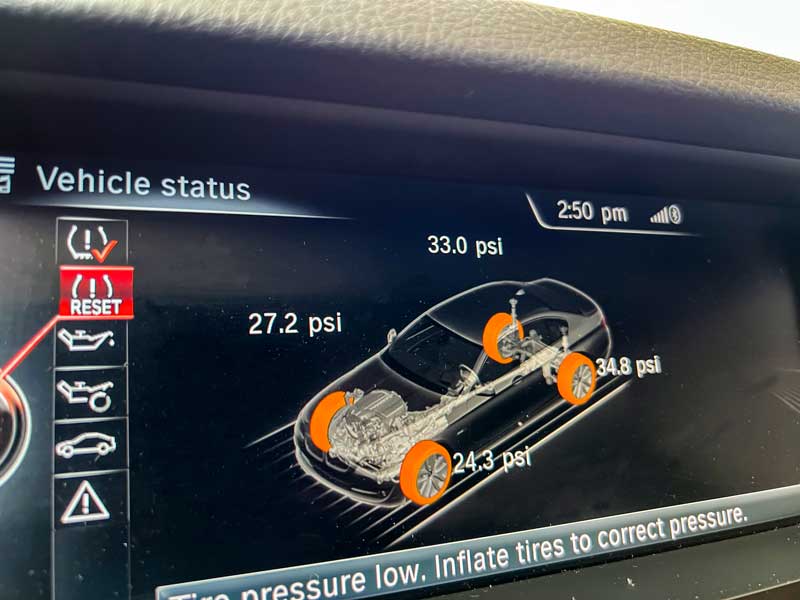
Some of the links on this page may link to our affiliates. Learn more about our affiliate policies.
Last Updated: December 28, 2023
I kept getting low tire pressure warnings on my car in early mornings or if the weather has been cooler outside. The interesting thing is that the pressure never seemed to drop below 24 psi, which got me puzzled. However, after inspecting my tires closer, I realized that all of my tires are run-on-flats, therefore sturdy sidewall didn't let the weight of the car to squeeze the last air out of them.
While it's cool and all that I still have some air, it started happening so often that it got tiring to keep going to the gas station and pay $2 per fill up. I took my car to a mechanic and a tire shop to get it inspected, only to be told that tires are in great condition, however they might be getting old and therefore they aren't sealed to the wheel as well anymore. This meant that I either have to fork out the money to purchase a new set of tires, or continue tossing $2 down the drain each morning.
Being as cheap as I am, I chose to purchase a tire inflator. However, I did not want to purchase just any tire inflator. It had to make sense financially, time wise (psi output), and convenience (cordless preferred). So off I went to hunt down the most perfect tire inflator that I can keep in my car.
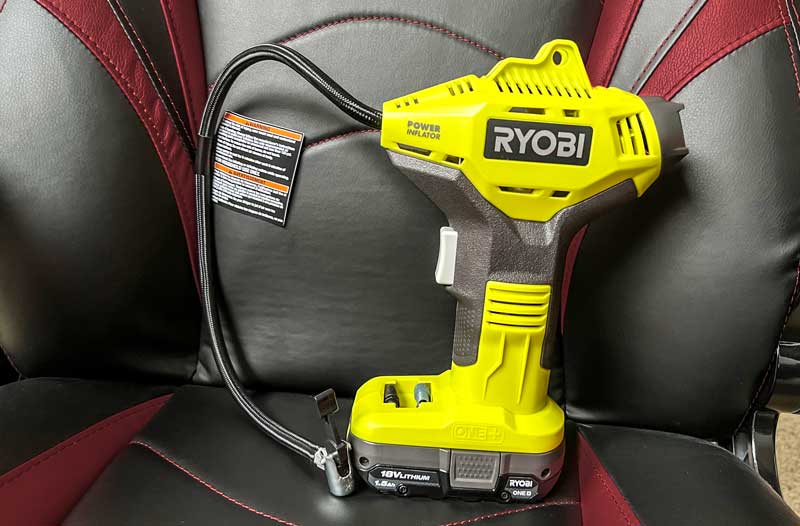
Many drivers have seen a warning light on their dashboards indicating low tire pressure. If the warning light remains on for more than a minute, you should stop driving and inspect your tires. Then, either pay the gas station pump for the air or use your tire inflator to fix the problem.
The right tire inflator will work in any situation. It can be battery-operated, 110-volt electrical, or plugged into your car's 12-volt system. These noisy day-savers will quickly raise your tire pressure to the ideal level.
Unfortunately, low-pressure tires cause driving problems, such as poor gas mileage, uneven tire wear, further damage to the tires and wheels, and ride quality. This guide will help you find the best tire inflators.
My Top 6 Tire Inflator Picks
- BEST OVERALL: Ryobi 18-Volt One+ Cordless Inflator
- BEST COMPACT: Makita M100DZ 12V Max Cordless Inflator
- BEST PLUG-IN: CRAFTSMAN V20 Inflator
- BEST BUDGET PLUG-IN: AstroAI Portable Air Compressor Pump
- BEST PLUG-IN FOR HOME: Kensun Portable Air Compressor Pump for Car 12V DC
- BEST MINI INFLATOR: CyCPLUS Portable Inflator Mini Pump
Best Overall: Ryobi 18-Volt One+ Cordless Inflator 🏆
This is the purchase that I went with myself. It is super easy to use and doesn't require much thinking. Just drop the battery in and get to work. The Ryobi PHP737D is a battery-operated tire pump that can inflate tires up to 150 PSI. It is easy and affordable. The pistol grip design makes it easy to use and ergonomic. It also houses two needles that can be used for blowing up pool toys or athletic balls. It weighs 2.5 pounds and features a snap-on 20-inch hose that fits standard tire valves.
The original P737D had an analog gauge. Ryobi upgraded it to a digital gauge, and it's a great addition. Although the Ryobi felt a bit bulky in my hand, it could fill any vehicle, even truck tires. Although it is heavier than other models due to the battery, it offers more power and has longer battery life.
One of the bigger downfalls of this inflator (however this seems to be a trend with all of them) is that it comes with no battery and the battery itself costs a pretty penny. What I did was, bear with me on this one, purchase a Ryobi drill that already comes with the battery and the charger and cost almost the same as the battery itself, so now I have two tools and a battery for the price of one tool and a battery.
Product Specifications:
- Rating: 4.6/5.0 stars on Amazon
- Model: P737
- Voltage: 18 Volts
- Sound Level: 78 dB
- Max PSI: 150 PSI
- Weight: 2.5 Lbs
- Product Dimensions: 9" x 2.86" x 6.4"
- Batteries Included? NO
Pros
- Operation Cordless
- It is simple to use
- Fills very quickly
Cons
- Bulky and difficult to handle
- Preset pressure is not necessary
- You may need to top it off
Best Compact: Makita M100DZ 12V Max Cordless Inflator
Makita MP100DZ 12V max CXT Cordless Inflator can pump up 120 PSI pressure to a car, bike, or tractor tire. The compressor is lightweight and compact, so it doesn't take up much space in the trunk. High-visibility pressure gauge displays the exact level of air pressure in the tire. The MP100DZ can be preset to turn off automatically when the tire has reached the desired PSI.
During testing, I found many things to love about the Makita tire inflator. The inflator was powerful and filled the tires quickly. It is also compact and easy to use during inflation. In addition, it was simple to set the pressure and accurate to within 1 PSI of your vehicle's tire pressure monitor.
Pros
- Operation Cordless
- Very light
- Fills quickly
- It is easy to set up
Cons
- It can be difficult to store accessories onboard
- A redesign could be done to the hose storage system
- LED light is a kind of novelty
Product Specifications:
- Rating: 4.5/5.0 stars on Amazon
- Model: MP100DZ
- Voltage: 12 Volts
- Sound Level: 72 dB
- Max PSI: 120 PSI
- Weight: 2.13 Lbs
- Product Dimensions: 2.95" x 8.27" x 6.93"
- Batteries Included? NO
- Warranty: 3-year limited warranty
Best Plug-in Tire Inflator: CRAFTSMAN V20
Craftsman V20CMC3520B is a top-quality inflator for tires that offers many power options. The inflator can be used on either 110V or 12V power. It also comes with a 4-Ah lithium battery for strong inflation power. The inflator also comes with a 20-inch flexible hose, a regulator, and an electronic pressure gauge. There is also a storage area for cords and hoses. The CMCE520B can hold 160 PSI at maximum pressure, sufficient pressure to fill your car or truck's tires. The compressor will shut off automatically when it reaches the desired pressure. This eliminates the possibility of your tires being overinflated.
The Craftsman compressor is a high-quality model. It also has a higher pressure than other models. This proved to be a great feature. It was convenient to have all the storage for the AC and DC wire attachments and the flexible tubing for floating and air mattresses. It also sits well on the ground when it fills, which is especially useful when combined with the automatic shutoff.
Product Specifications:
- Rating: 4.8/5.0 stars on Amazon
- Model: V20 / CMCE520B
- Voltage: 20 Volts
- Max PSI: 160 PSI
- Weight: 3.8 Lbs
- Product Dimensions: 12.52" x 7.95" x 6.46"
- Batteries Included? NO
Pros
- Operation Cordless
- Tests with the most pressure
- AC or DC connections
Cons
- It is more expensive than other options
- Bulkier than usual tire inflators which can become problematic with storage
Best Budget Plug-In Tire Inflator For a Car: AstroAI
A compressor may not be available if a tire experiences a loss of pressure in a parking lot at a mall or campsite. However, the 12-volt battery powering the AstroAI tire inflator can be found in a car. Turn on the accessory mode and plug it into the car's 12V Jack. This will provide the power needed to maintain a low tire or get it to the tire shop for repair. It also features an LED flashlight that improves visibility. The compact pump can fit into almost any trunk. It also comes with adapters to use pool floats or sports balls. The backlit pressure gauge makes it easy to read.
The AstroAI portable compressor is very well-designed. It looks and works exactly like a small commercial horizontal compressor. The group's digital gauge at the top was also the most impressive. Although it took some time to pump up the truck tires, the readings were accurate, thanks to the vehicle's TPM system. The rubber feet also made the process much quieter.
Product Specifications:
- Rating: 4.5/5.0 stars on Amazon
- Model: A220B
- Voltage: 12Volts
- Sound Level: 80 dB
- Max PSI: 100 PSI
- Weight: 2.2 Lbs
- Product Dimensions: 8.27" x 3.74" x 6.69"
- Plug-in? Yes
Pros
- Tested very well
- Cool, compact design
- Many accessories
Cons
- Other recommendations are not as effective as theirs
- Heats up fairly quickly
- A bit noisy
Best Tire Inflator for Home: Kensun 12V DC
The Kensun compressor is flexible. It can be used with 12V power from a car and 110V power at home. This kit includes a needle to make sports balls and an adapter to blow up pool floats or other inflatables. The unit can withstand 120 PSI for up to 30 minutes and then shuts off automatically.
The Kensun Portable Air Compressor's best feature is its simplicity of operation. There are just two buttons for each power source. It was powerful enough to fill a truck's tires and worked well with basketball and bike tires. However, it is not very accurate and difficult to read. I had to stand by it to ensure it did not overinflate the tires, as there were no auto shutoff settings.
Product Specifications:
- Rating: 4.4/5.0 stars on Amazon
- Model: EHRComp-A58B
- Voltage: 12Volts
- Sound Level: 92 dB
- Max PSI: 120 PSI
- Weight: 3.96 Lbs
- Product Dimensions: 11.8" x 4.3" x 6.7"
- Plug-in? Yes
Pros
- It's easy to use
- Includes a carrying case
- Powerful
Cons
- It is difficult to put away and wrap.
- It is difficult to read an analog gauge
- Smaller trunks may not be able to handle the bulk.
- It's noisy
Best Mini Tire Inflator: CYCPLUS A2B
This Cyprus mini inflator is great for those who need a small inflator to fit in their backpacks or glove boxes. The tiny Cycplus mini inflator measures just 7 inches in length and can produce up to 150 PSI to inflate motorcycle tires or car tires. The pump also features an LED flashlight and digital pressure gauge. It can charge completely in two-and-a-half hours and is a portable power bank for charging mobile phones and other electronic devices. You can also store your air tube and other accessories onboard.
Amazingly, the mini inflator was the biggest surprise for the group. Although it's not designed for truck tires, I didn't have a car, so a truck-rated tire was the only option. It did the job. Although it got hot, the battery could only fill one tire after the other two were filled with basketball and bike tires. However, it was able to do the job. Although it is small enough to fit in a glove box, it has enough power to fill a low tire. It's not something I would use to fill multiple tires, but it works well in a pinch.
Product Specifications:
- Rating: 4.2/5.0 stars on Amazon
- Model: A2B / CDZN008
- Voltage: 12Volts
- Max PSI: 150PSI
- Weight: 0.74 Lbs
- Product Dimensions: 7" x 2.1" x 2.1"
- Batteries included? Yes
Pros
- Compact but powerful
- Able to pump a truck's tire
- By far the lightest air inflator on the list
Cons
- Heats up quickly
- Battery life could be a problem
How to Use a Tire Inflator?
- Make sure you fill your tires to the recommended pressure. Check the tire's sidewall inside the vehicle's doors to determine the recommended pressure. This is typically between 30-40 PSI for trucks and cars. This range allows for even tread wear, comfortable riding, and better gas mileage.
- Inflators that aren't putting pressure may have a problem. A puncture or excessive wear could cause a hole in your tire. If the tire cannot build pressure as should, be sure to inspect the condition.
- Fill bike tires with Presta Valve adapters. Sometimes the inflator's end doesn't attach to a bicycle's valve stem. While most car and bike tires use Schrader, some bikes use Presta valves. An adapter may be needed for these tires.
What to Look For When Choosing the Best Tire Pump
It's helpful to know some background information before you start comparing products. This section will discuss the main considerations when shopping for a tire inflation device. These factors should be taken into consideration when you make your decision.
What is the Power Source for the Tire Inflator?
To fill your tires, tire inflators use motors and pumps. To do this, they need power. There are two options for them: corded or cordless. To run your car's battery, corded inflators using 12V power can be plugged into the 12V jack. Some might clip to the battery like jumper cables. These inflators don't need to be charged with an extra battery. The inflator will work as long as your car has enough power.
Most corded inflators are powered by 12V, but some flexible models can use 12V or 110V power. These models can be plugged into standard outlets and 12V power jacks. The cordless inflators run on batteries and require rechargeable batteries to operate the pump and motor. Some cordless inflators have built-in batteries, which can be charged via USB or 110V power. Others have removable batteries.
Because they don't need an additional power source to fill tires, cordless inflators are more flexible than 12V corded inflators. As a result, they are equally adept at filling bicycle tires and sporting equipment and pumping air into car tires.
Operating Pressure
Pressure is often equal to speed when it comes to tire inflators. A tire inflator that can produce more pressure can fill tires faster. Compressors with at least 100 PSI are recommended to save time when filling tires. An inflator that can hold 150 PSI or more will get it running faster. Most tire inflators will fill your tire to the recommended 30-40 PSI.
Inflation Times
The time it takes to inflate a tire can play a major role in choosing the right tire pump. Inflation time can take 10 to 30 minutes, depending on the tire inflator's output. Therefore, the quicker a vehicle or bicycle can go on the road, the less time it takes to fill a tire.
Duty cycle
Air compressors work on what is known as a "duty circle." This describes the time a compressor can run before it needs to cool down. Tire inflators are limited to running for around 15 minutes before they need to stop. To produce the required pressure, they must run at high speeds. Compressing air creates heat. Their compact design retains heat and is not as efficient as full-size compressors. The larger compressors can fill a tank with air, then turn it off, which makes the duty cycle less important (except for commercial applications).
While shorter duty cycles are not usually an issue for filling pool floats and other equipment, they can cause problems filling large truck tires. Many portable tire inflators are not made for truck tires. However, they can be used in an emergency.
Gauge Readability
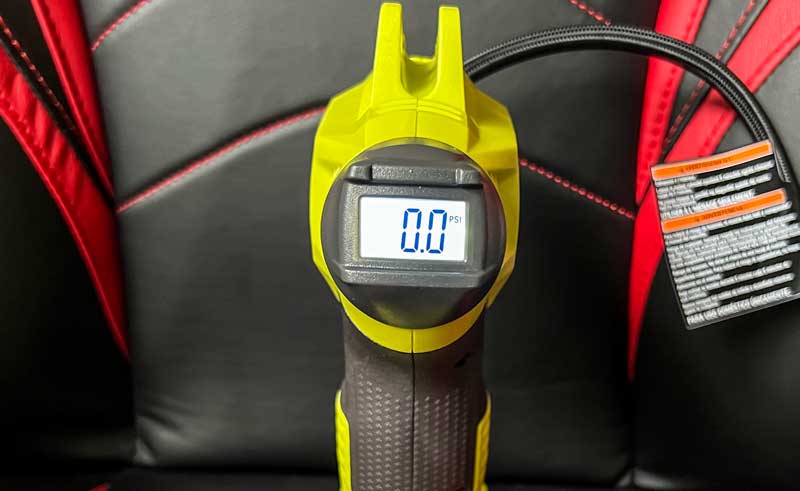
Fill your car tires with the recommended pressure to get the best wear and mileage. For regular cars typical recommended tire pressure is 35 PSI. For sports cars without run-on-flats, a lot of times the recommended tire pressure is 32 PSI. For semi-trucks, recommended tire pressure is around 100 PSI.
A tire inflator must have a clear gauge to ensure that the correct amount of air is being injected into the tires. Digital gauges make it easier, especially if there is a backlit or light background. Analog gauges work well when the faces of the gauges have large numerals. However, analog gauges aren't equipped with a backlight, so it cannot be easy to read them in low-light situations.
Automatic Shutoff
Although small air compressors can be tough and durable, they can overheat if left on for too long. So manufacturers include automatic shutoff functions to protect their tire inflators. A tire inflator can only take three measurements before it automatically shuts off: temperature, pressure, and time.
The pressure shutoff is especially useful because it can be set at the desired pressure and will stop pumping air when the tire reaches that level. The inflator will also shut off if it reaches a dangerous temperature (usually around 200 degrees Fahrenheit). Finally, after running for a set amount of time (usually around 15 minutes), a built-in shutoff can start a cooling process.
Convenience features to look for when shopping for a tire inflator
Hose Length
A short hose can be difficult to fill a tire. However, it is much more fun than tripping on a long, tangled tube. A tire inflator that has a 16-to-20-inch hose works best. It is long enough to reach most tires but manageable.
A tire inflator with a coil hose will give you a longer, more manageable hose. These hoses are very flexible and can fill all four tires with ease. These inflators are great for large vehicles such as pickup trucks or SUVs.
Ease of Use
The tire pressure warning light should flash quickly if there has been a pressure loss over the night. It is important to have a simple tire inflator. Although tire inflators can be simple to use, some features can make them even more convenient. A programmable pressure regulator, for example, will stop you from overfilling your tire. A built-in pressure gauge is another useful feature. It shows the tire's pressure without needing to take out the hose and check it with another gauge.
Weight and portability
A tire inflator is often preferred to a standard compressor due to its portability and lightweight. In addition, you can easily carry a tire inflator in one hand, as it can weigh less than 1 pound. A tire inflator is a useful tool for road trips. However, trunk space can become tighter on longer trips. A compact inflator can be easily stored in your trunk and won't take up much space for snacks or luggage. While most tire inflators can fit this description, compact models require even less space.
Best Tire Inflator Testing Methodology
I tested the models in this list to ensure I only recommend the best tire inflation. As my subjects, I tested these items on my personal car. Yes, it took a bit of a beating for me deflating the tires and inflating them back up. Since my car is currently running the run-on-flat tires, the tire pressure was stubborn to drop below 20 PSI, therefore all of the tests were conducted from 20 PSI to 35 PSI.
Since we are in an interesting economic times, I assured to only test the most reasonably priced tire inflators and steered clear from excessively expensive ones. However, I also stayed away from the obvious Ali Express or Ali Baba drop ship tire inflators (not to say that all of them are bad). There were 3 full days of research that went into the research for which products to tests to begin with. Many articles were read as well as customers' reviews on Amazon, Home Depot, and similar sites.
First, I used the vehicle's tire pressure monitor system to determine the proper pressure. After the tire pressure had dropped to the desired level, I connected the inflator to the tire and recorded the time it took for the tire to pump up. This gave me a good idea of how powerful and long-lasting these inflators might be.
Best Tire Inflators Final Words
A tire inflator can be used to either fix low tire pressure or fill up a basketball. No matter what I used them for, the various tested inflators met my needs. The Ryobi tire pump is my favorite for quick and accurate tire inflation. With the little money saving trick that I have shared with you above, you are surely not going to lose out on that combination deal.
Frequently Asked Questions

Steven Dillon
Author
Steven is the founder and product tested for The Car Data, that has extensive knowledge in automotive industry. While most of his free time he participates in typical "car guy" activities, his passion for cars, data analytics, and tech, always has his looking for the next cool tool, software, trend, etc. to share with his audience on The Car Data or on his Instagram.


